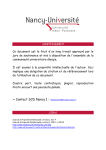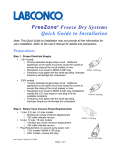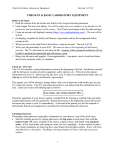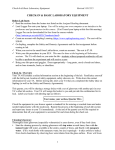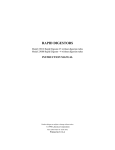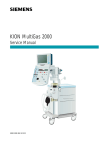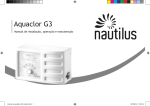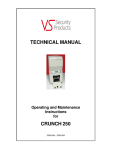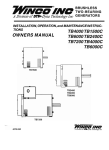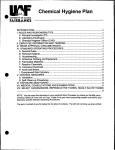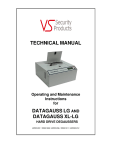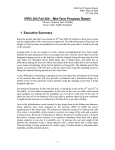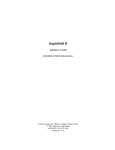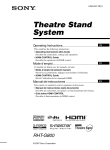Download User`s Manual
Transcript
User’s Manual Open Combination (Macro) Kjeldahl Systems Models 21232 Series 21233 Series 21236 Series 21237 Series To receive important product updates, complete your product registration card online at register.labconco.com Labconco Corporation 8811 Prospect Avenue Kansas City, MO 64132-2696 800-821-5525, 816-333-8811 FAX 816-363-0130 E-MAIL [email protected] HOME PAGE www.labconco.com Please read the User’s Manual before operating the equipment. Copyright © 2010 Labconco Corporation. All rights reserved. The information contained in this manual and the accompanying products are copyrighted and all rights reserved by Labconco Corporation. Labconco Corporation reserves the right to make periodic design changes without obligation to notify any person or entity of such change. Warranty Labconco provides a warranty on all parts and factory workmanship. The warranty includes areas of defective material and workmanship, provided such defect results from normal and proper use of the equipment. The warranty for all Labconco products will expire one year from date of installation or two years from date of shipment from Labconco, whichever is sooner, except the following; • • • • • Purifier® Logic® Biological Safety Cabinets and PuriCare® Lab Animal Research Stations carry a three-year warranty from date of installation or four years from date of shipment from Labconco, whichever is sooner. SteamScrubber® & FlaskScrubber® Glassware Washers carry a two-year warranty from date of installation or three years from date of shipment from Labconco, whichever is sooner. Blood Drawing Chairs carry a ten year warranty. Carts carry a lifetime warranty. Glassware is not warranted from breakage when dropped or mishandled. This limited warranty covers parts and labor, but not transportation and insurance charges. In the event of a warranty claim, contact Labconco Corporation or the dealer who sold you the product. If the cause is determined to be a manufacturing fault, the dealer or Labconco Corporation will repair or replace all defective parts to restore the unit to operation. Under no circumstances shall Labconco Corporation be liable for indirect, consequential, or special damages of any kind. This statement may be altered by a specific published amendment. No individual has authorization to alter the provisions of this warranty policy or its amendments. Lamps and filters are not covered by this warranty. Damage due to corrosion or accidental breakage is not covered. Returned or Damaged Goods Do not return goods without the prior authorization from Labconco. Unauthorized returns will not be accepted. If your shipment was damaged in transit, you must file a claim directly with the freight carrier. Labconco Corporation and its dealers are not responsible for shipping damages. The United States Interstate Commerce Commission rules require that claims be filed with the delivery carrier within fifteen (15) days of delivery. Limitation of Liability The disposal and/or emission of substances used in connection with this equipment may be governed by various federal, state, or local regulations. All users of this equipment are required to become familiar with any regulations that apply in the user’s area concerning the dumping of waste materials in or upon water, land, or air and to comply with such regulations. Labconco Corporation is held harmless with respect to user’s compliance with such regulations. Contacting Labconco Corporation If you have questions that are not addressed in this manual, or if you need technical assistance, contact Labconco’s Customer Service Department or Labconco’s Product Service Department at 1-800-8215525 or 1-816-333-8811, between the hours of 7:00 a.m. and 6:00 p.m., Central Standard Time. Part #2081400, Rev. U ECO G001 TABLE OF CONTENTS CHAPTER 1: INTRODUCTION Components Shipped General Description Performance Component Identification 1 1 2 3 3 CHAPTER 2: INSTALLATION General Installation Notes Location Electrical Tap Water Supply Distillation Manifold Water Aspirator Exhaust System Acid Fume Blower Exhaust System Blower Airflow Exhaust Volume Requirement & Velocity Test Digestion Rack Drip Shield Glassware Installation 6 6 6 7 8 8 9 11 11 12 13 CHAPTER 3: NORMAL OPERATION & ROUTINE MAINTENANCE Normal Operation Start-Up Clean-Up and Cosmetic Guidelines Fume Removal Manifold Suction Adjustment Exhaust Systems Maintenance Drip Shield 14 14 15 15 15 16 APPENDIX A: REPLACEMENT PARTS 17 APPENDIX B: DIMENSIONS & AIRFLOW REQUIREMENTS 19 APPENDIX C: TOTAL KJELDAHL NITROGEN METHOD 20 Chapter 1: Introduction Components Shipped Carefully check the contents of your Open Combination Kjeldahl System for shipping damage while it is still on the shipping pallet. Do not discard the packaging material until the contents have been checked and the equipment has been approved for installation. The Open Combination Kjeldahl Nitrogen System has been shipped in one complete crate to minimize damage that may occur in transit. Make sure to inspect the product thoroughly prior to installation and report any damage that may have occurred in transit (see Warranty page for instructions). Figure 1-1 Product Service 1-800-522-7658 1 Chapter 1: Introduction General Description Labconco’s Open Combination (Macro) Kjeldahl Nitrogen System is designed to facilitate the determination of Total Nitrogen content within materials such as feeds, grains, soils, fertilizers, plant tissue, water, organic wastes, and food products. The expression ‘Macro’ identifies the size of sample vessel and the sample size that can be used with this equipment. Other Kjeldahl systems are available, which use smaller sample vessels and require smaller sample sizes. The apparatus can be used for the digestion and/or distillation of all types of nitrogen containing samples. The system consists of the Lower Digestion rack and Upper Distillation rack. Both are used in standardized (Macro) Kjeldahl Nitrogen Determination Methods. This Kjeldahl system is not enclosed, excess heat and personnel safety during the digestion and distillation reactions should be considered when selecting an installation location. High temperature acid digestion and caustic distillation comprise the two-step Kjeldahl Nitrogen determination method. 2123202 Six Place Open Combination Macro-Kjeldahl System 2 Product Service 1-800-522-7658 Chapter 1: Introduction Performance The Open Combination Kjeldahl Digestion and Distillation Systems have been designed for use in the determination of nitrogen (or ammonia) concentrations. By calculation nitrogen can be converted to protein values for products such as plant tissues, meats and other food substances. Nitrogen determinations with the Open Combination (Macro) Kjeldahl Systems can accommodate sample sizes up to 5 grams due to the size of the digestion/distillation flasks. However, higher levels of organic content within a specific sample type will require smaller sample sizes due to the vigorous digestion reaction. Detailed procedures developed by professional laboratory organizations such as American Association of Analytical Chemists (AOAC) and American Association of Cereal Chemists (AACC) should always be consulted for step by step analytical procedures when operating this equipment. For methodology precision and accuracy please consult the specific published method for the type of sample or substance that will be analyzed. Component Identification 1. Electric Heaters. 600-watt heaters are used in both the lower digestion and upper distillation rack of the unit. Infinite control switches regulate each of the heaters. The curved heater elements are provided and allow for the round base of the Kjeldahl Flasks, providing faster and more evenly distributed heat. The heating element assembly on the digestion rack can be moved closer to or away from the acid fume removal manifold to accommodate different size Kjeldahl flasks. All heaters and temperature controllers are wired to a common electrical box for connection to a facility electrical service. 2. Lower Fume Removal Manifold. Located in back of the digestion heater elements, this manifold is manufactured from chemical resistant chlorinated polyvinyl chloride and fitted with heat resistant Teflon® nipples designed to prevent leakage of the hot sulfuric acid fumes created during the digestion process. The nipple design, extends in to the flask opening, and efficiently removes excess acids fumes during the digestion process. The flasks are oriented at a 45 degree angle to the fume removal manifold to promote the condensation and refluxing of the acid fumes back down into the digestion flask. This refluxing process prevents the samples from boiling dry during the 45+ minute digestion process. Component features #3 or #4 are selected by the customer when the product is ordered. The Kjeldahl units described in this manual feature either the blower exhaust or water ejector exhaust system to remove the digestion fumes through the fume manifold system. ® Teflon is a registered trademark of E. I. du Pont de Nemours and Company or its affiliates. Product Service 1-800-522-7658 3 Chapter 1: Introduction 3. Acid Fume Blower Exhaust System. Located on the left side of the unit, this blower removes excess sulfuric acid fumes from the digestion flasks. The blower is direct-drive with corrosion resistant impeller wheel. The blower draws the sulfuric acid fumes through the CPVC digestion manifold and discharges the fumes under positive pressure out through a duct work system connected to the buildings exterior. The 6" exhaust stack of the blower must be connected to a leak-tight PVC ductwork system that vents 10 ft (3 meters) above the building roof. 4. Acid Fume Water Aspirator Exhaust System. A water aspirator fume removal system located on the left side of the digestion fume manifold is alternatively available on Kjeldahl systems. The water aspirator draws excess acid fumes by producing a vacuum in the digestion manifold and the flask nipples. The acid fumes are dissolved in the water and flushed to a 3-inch drain connection. The water ejector includes an air-vent pipe connection, which must to ducted to the roof of the building. The vent pipe prevents an air-lock from occurring within the water aspirator. The water aspirator requires a 3/4" NPT water connection with 60 psig and 68 gallons per minute flow rate in order to operate. 5. Temperature Gauge The condensation rack behind the upper distillation heating elements requires cooling water. The temperature of the distillation cooling water can be adjusted to promote condensation and suit individual requirements with the flow control valve handle, located below the distillation heaters. Water temperature is indicated on the thermometer, which is located at the water outlet of the distillation manifold. The water connections are 3/4" NPT and the supply line should be 1/2" minimum for proper water flow through the unit. For facilities where the ground water temperature exceeds 80°F (27°C), a recirculation water chiller system will be required to achieve sufficient condensation results. 6. Distillation Condensation Manifold Epoxy coated steel outer columns with stainless steel inner condensation columns provide long life. Each of the six column manifold features 3/4" NPT tap water inlet and outlets for easy plumbing connections. 4 Product Service 1-800-522-7658 Chapter 1: Introduction 5 6 1 4 3 2 Figure 1-2 Product Service 1-800-522-7658 5 Chapter 2: Installation General Installation Notes The Open Combination Macro-Kjeldahl System is shipped fully assembled. Exhaust duct work, electrical service, water supply and drain connections should be completed by a licensed contractor. The customer will need to purchase their preferred size of Kjeldahl Flasks, with one-hole-rubber-stoppers and distillate receiving flasks. The glass Connecting Bulbs and Delivery Tubes are provided with each Kjeldahl System. Figure 2-1 Connecting Bulbs and Delivery Tubes are included with Macro Kjeldahl Systems. For installation of the Connecting Bulbs and Delivery Tubes see section on Glassware Installation and Figure 2-8. Use caution when you remove the protective packaging material taped to the heater runways as fragile components are involved. Levelers are shipped installed, as are the distillation cooling water thermometers. Location If possible, the apparatus should be uncrated in the room in which it is to be placed. Open Combination Macro-Kjeldahl Systems are heavy and can not be disassembled to reduce their overall size. Special arrangements should be made in advance for moving the systems to their final location within a facility. Special instruction tags are attached to the apparatus; they must not be removed until the installation has been completed. The Open Combination Kjeldahl System does not include a safety enclosure. Labconco advises installing this Kjeldahl in a location segregated away from normal Laboratory personnel traffic. High heats along with boils acids and caustics present a safety hazard to personnel in close proximately to the Open Combination Kjeldahl System. Labconco also recommends spot exhaust ventilation for the final installation location to remove excess heat produced by the Kjeldahl digestion and distillation heaters. 6 Product Service 1-800-522-7658 Chapter 2: Installation Electrical Open Combination Macro-Kjeldahl Systems have been wired at the factory per the product model number ordered by the customer. Labconco model numbers ending in 01 are 115 volts. Model number ending in 02 are 230 volts. Models ending in 03 are 230 volt, three phase. Amperage requirements vary depending on the number of heaters per the digestion rack. The tables below provide the voltage and amperage electrical requirements for the Open Combination Macro-Kjeldahl Systems. A qualified electrician will need to connect the facility electrical supply to the main breaker box with its individual circuit breakers. The following basic steps should be followed: 1. Remove circuit breaker box cover panel. 2. Main line lead connection terminals are identified and connections must be made accordingly. 3. Line leads to the apparatus must conform to local electrical codes. 4. Provide an electrical ground to the apparatus per code. 5. Before applying power to apparatus, check the electrical panel and breakers for loose connections. 6. Reinstall box cover panel. 7. Power the breaker box and reset breakers to check circuits in the apparatus. 8. All electrical wiring and connections must conform to local codes and should be performed by qualified electricians. An earth ground must be provided. Figure 2-2 Product Service 1-800-522-7658 7 Chapter 2: Installation Tap Water Supply NOTE: ALL PLUMBING CONNECTIONS AND COMPONENTS MUST BE FREE OF FOREIGN MATERIAL BEFORE FINAL CONNECTIONS ARE MADE. Distillation Manifold The Open Combination Macro-Kjeldahl Systems feature an upper distillation rack with individual condensation columns, these are connected together by a common manifold (6 columns per manifold). The tap water inlet and outlet connections are 3/4" NPT and the supply line should be minimum 1/2" ID for proper water flow and heat removal capacity through the condensation columns (6-8 gallons/23-30 liters per minute). Open Combination Macro-Kjeldahl Systems with 12 or 18 heaters per rack will include two or three, 6 column manifolds which are connected together in series. The plumbing line for the outlet of the distillation manifold must be free of back pressure to avoid flow restriction of the cooling water. If the Open Combination Macro-Kjeldahl is equipped with the Acid Fume Water Aspirator Exhaust System option, the distillation water drain should not be connected to the aspirator drain. Unless provisions are made to handle the larger water volumes without water backing up over the aspirator vent line. Water discharged from the distillation manifold is not acid contaminated and standard drain lines may be used for its removal. Distillation Manifold Tap Water Connections Figure 2-3 8 Product Service 1-800-522-7658 Chapter 2: Installation Water Aspirator Exhaust System Figure 2-4 For models with a Water Aspirator For correct operation, the water aspirator’s 3/4" NPT connection must be connected to a 3/4" supply line with a minimum of 60 psi line pressure. The water aspirator system is sized for use with a nominal 3" dia. line. The aspirator discharge pipe terminates with a 3" dia. PVC coupling to drain and a 11/2" dia., 45° vent coupling for connection to an air roof vent. The discharge drain for the aspirator must be acid proof, the discharge water will be acidic. The drain should be capable of carrying up to 6 gpm (23 lpm) of discharge without backing up over the 45° air vent connection on the aspirator. See plumbing diagram. The 1-1/2" dia. vent line must be vented to the roof, which prevents an airlock from occurring within the fume removal manifold and prevent back pressure from building up within the aspiration system. This vent must be acid resistant material; acid fumes will be exhausted to the outside through this vent line. As previously mentioned the drain line must be free of back pressure to prevent closing of the atmosphere vent and stopping the removal of the acid fumes through the manifold. The drain on the water ejector system should be a sealed installation to avoid fumes in the laboratory. Inside the water aspirator, the position of the water nozzle relative to the fume manifold is factory set and should not require field adjustments for normal conditions. Care should be taken to maintain this “set” position when connecting the water line to the aspirator and should be checked periodically to be maintained in optimum working condition. Product Service 1-800-522-7658 9 Chapter 2: Installation Water Aspirator Acid Fume Removal System Figure 2-5 Do not locate trap directly below water ejector stub, or water may backup into the air vent and stop the fume removal through your exhaust manifold. 10 Product Service 1-800-522-7658 Chapter 2: Installation Acid Fume Blower Exhaust System The exhaust duct connection on top of the blower is sized for use with 6" nominal (6-5/8" O.D.) vent duct. The blower assembly is supplied with a short piece of 6" PVC pipe and a flexible coupling with clamps to connect the blower housing assembly to the duct work exhaust stack. Joints under the flexible coupling must be sealed with an acid-resistant sealant (silicone or acid resistant cement) before tightening clamps to prevent leakage of acid condensate at this point. Flexible Coupling A Sealant PVC Coupling Acid Condensate Drain Tube Figure 2-6 The bottom of the blower housing is fitted with a condensate drain and corrosion resistant tubing. This condensate (identified by “A” above and on the next page) can be collected in a closed acid proof container, which should be emptied regularly or it may be plumbed to an acid resistant drain line. The condensate is concentrated acid and care must be exercised when handling it. Blower Airflow Exhaust Volume Requirement & Velocity Test Cubic feet per minute = 25 Average airflow velocity = 117 feet per minute The Kjeldahl’s blower airflow volume test is based on the "Pitot Traverse in Inlet Duct" method described in the ANSI/ASHRAE 51-1999 standard. Duct velocity measurements are taken at 48" from the blower using a 6 point duct traverse pattern (Industrial Ventilation 24th Edition p. 9-10). Product Service 1-800-522-7658 11 Chapter 2: Installation (Duct Area in Square Feet) x (Average Airflow Velocity in feet per minute) = (Air Volume CFM) (Pi) radius² X 117 FPM = 25 CFM The exhaust stack rising from the blower exhaust connection must be vented to the outside atmosphere. A 6" diameter duct is sufficient for carrying the fumes a distance not exceeding 60 feet. In estimating the duct length count each 90° elbow as 12 feet and add to the straight length total of duct for the duct system. If the duct system exceeds 60 feet in equivalent length, it may be necessary to increase the duct size to compensate for the friction loss generated by this additional length. WARNING: Acid resistant duct must be used on the exhaust connection on your Kjeldahl Apparatus. Highly corrosive fumes produced from boiling sulfuric acid will flow through the ductwork, so acid-resistant duct must be used. Polyvinyl chloride (PVC) or fiberglass duct is recommended. The exhaust duct work must be supported independent of the Kjeldahl System to avoid distortion of the blower housing. Digestion Rack Drip Shield The digestion heaters are located in a drip shield and constructed of stainless steel which is resistant to acid attack. Liquid acid spills that occur can be drained to an acid resistant container with the drip tube located on the left side of the digestion rack. Blower Acid Drip Tube and Digestion Rack Drip Tube Figure 2-7 12 Product Service 1-800-522-7658 Chapter 2: Installation Glassware Installation Connecting Bulb Rubber Tubing Distillation Manifold Delivery Tube Distillation Flask Receiving Flask Figure 2-8 Product Service 1-800-522-7658 13 Chapter 3: Normal Operation & Routine Maintenance Normal Operation Start-Up 1. The KNA apparatus is designed for use with either 500 or 800-ml Kjeldahl Flasks. The digestion heaters are free to move forward or backward on the runway to accommodate either size flask. 2. Turn the heat controllers to the setting on both the Digester and Distillation racks if both racks will be used simultaneously. Wait approximately 5 to 10 minutes to insure proper preheating. Sample chemistry limits the boiling temperature of the sample, so the high heat setting may be used. 3. Start the acid fume removal blower or water aspirator (depending on model number purchased). Place a small piece of tissue paper over the nipple on the digestion manifold. Suction should be sufficient to hold 2" x 2" (51 mm x 51 mm) tissue paper in place. 4. Begin the distillation cooling water and check for leaks. For correct operation of the condensers, the temperature of the cooling water should not exceed 80°F (27°C). Watch your thermometer and regulate water flow by the control valve 5. The inner stainless steel condensing tubes on the distillation apparatus should be rinsed out by boiling nitrogen free water in Kjeldahl flasks attached to the condensation columns before commencing a distillation procedure. A generalized Kjeldahl Total Nitrogen method is present in Appendix C. The method does not detail sample preparation or preservation procedures, which may be required depending on specific types of samples. 14 Product Service 1-800-522-7658 Chapter 3: Normal Operation & Routine Maintenance Clean-Up and Cosmetic Guidelines • • • Keeping the Open Macro Kjeldahl System clean will preserve the appearance and improve life of the equipment. The equipment can be kept clean by washing with a weak solution of sodium hydroxide and rinsing with clear water. Sulphate, a salt of Sulfuric Acid, may build up between the channel support and the fume removal manifold. Neutralize this with a weak solution of sodium hydroxide periodically to keep the unit clean. Fume Removal Manifold Suction Adjustment The suction along the fume removal manifold is adjusted as follows: Water Aspirator Exhaust System Suction is adjusted by changes in the water supply flow rate. The suction may be decreased by reducing the flow rate. Blower Exhaust System No adjustment is required on the suction pressure at the manifold when used. The blower fan should be inspected annually for debris and proper operation. Exhaust Systems Maintenance Sometimes the suction in the nipples is reduced due to obstruction within the exhaust system. These obstructions can usually be washed from the fume pipe, blower housing or water ejector by boiling water in a number of flasks placed on the digestion heaters. The blower or water aspirator should be in operation to draw the steam through the fume pipe. The direct drive motor should be lubricated in accordance with the manufacturer’s recommendations for heavy-duty usage by adding appropriate minimal drops of S.A.E. 10 automotive type oil annually or at least every 1500 hours of operation. CAUTION: Do not oil excessively! Product Service 1-800-522-7658 15 Chapter 3: Normal Operation & Routine Maintenance Drip Shield The drip shield is constructed of stainless steel and is resistant to most acid attack. Acid spills can however cause discoloration and eventual marring of the surface unless the following proper procedures are followed in their clean up. 1. Promptly wash down all major acid spills contained by the shield. 2. Periodically clean the stainless surface with any residential stainless steel sink cleaning compound. 3. After cleaning, renew the bright shiny appearance by lightly sanding with 220 grade emery paper. 16 Product Service 1-800-522-7658 Appendix A: Replacement Parts Electrical Heaters and Motor/Blower Parts Part Number Description 1315400 1315500 2011500 2023200 2033100 2033200 2023100 2031800 1870200 1317100 1850500 2053900 1200000 1203200 1203600 1851800 2054500 1451300 2056600 2055400 2055500 1851100 2053000 1967000 2144600 1662200 2165800 1880128 2164000 Heater Control, Infinite (115Volts) Heater Control, Infinite (230Volts) Core Plate Casting, (package of 6) Heater Base Casting (electric or gas) Heater element, 115V, 600 W, (package of 6) Heater element, 230V, 600 W, (package of 6) Heater Top ceramic casting (electric or gas) Heater lead wire assembly, (package of 6 pairs) Knob for Infinite Heater Control Blower Motor Switch Adjustable sheave (pulley) for belt drive blower only Blower housing assembly (plastic housing only) Blower motor 1/3 H.P., 115V, 60 Hz Blower motor 1/3 H.P., 230V, 60 Hz Blower motor 1/3 H.P., 230V, 50 Hz Blower shaft bearing (belt drive only) Blower bearing assembly Blower wheel Ceramic nipple Cover, blower wheel Blower Shaft (belt drive only) V-belt (drive only) Water ejector nozzle Clamp, hose Flex sleeving Grommet 1/2 ID x 1-1/2 OD Teflon nipple Plastic screws for Teflon nipple Motor shield Product Service 1-800-522-7658 17 Appendix A: Replacement Parts Miscellaneous Replacement Parts Part Number 1620500 2152402 2038800 2038900 2031700 2146400 2081300 2128800 2078800 18 Description Tubing, rubber condenser connecting, per foot Distillation manifold – 6 place stainless steel Wire, No 14 Black, SEWF-2, 30 ft length Wire No. 14 White, SEWF-2, 30 ft length Heater terminal assembly, package of 24 Assembly inlet & outlet manifold (12 unit only) Connector bulb/caustic trap, package of 6 Delivery tube, package of 6 Kit, replacement fume pipe to blower housing Product Service 1-800-522-7658 Appendix B: Dimensions & Airflow Requirements B-1 Product Service 1-800-522-7658 19 Appendix C: Total Kjeldahl Nitrogen Method Titrimetric Determination Various scientific associations offer approved Kjeldahl methods. These methods are available at their websites. The AOAC International (Official Methods of Analysis), Association of American Cereal Chemists (Approved Methods), American Oil Chemists Society, Environmental Protection Agency (EPA Methods for Chemical Analysis of Water and Wastes), International Standards Organization, The National Forage Testing Association, and United States Department of Agriculture. This methodology is for reference only. It is not a citable document. It is based on data we believe to be reliable. It is offered in good faith but without guarantee. 1. Scope and Application 1.1. This method determines the Total Kjeldahl Nitrogen (TKN) in water, and organic substances. There are three steps within the method: 1. the digestion procedure – which converts organic nitrogen to ammonia, 2. the distillation procedure - transferring ammonia from the digested sample to an ammonia trapping solution 3. sample titration – the quantification of ammonia in the trapping solution. NOTE 1: Some compounds containing nitrogen may not be converted; such as amines, nitro-compounds, hydrazones, oximes, semicarbazones and some tertiary amines. 1.2. This method is described for use with Kjeldahl equipment using Macro-Size glassware (500 - 800 ml flasks). 2. Definitions 2.1. TKN is defined as the sum of free-ammonia and organic nitrogen compounds, converted to ammonium sulfate (NH4)2SO4 by acid digestion. 3. Apparatus 3.1. Digestion Apparatus: A Kjeldahl digestion apparatus with multiple 600 watt electric burners, using 500 - 800 ml flasks and a fume removal manifold system. 3.2. Distillation Apparatus: A Kjeldahl distillation apparatus with multiple 600 watt electric burners, using 500 - 800 ml flasks. The distillation system includes connecting bulbs to prevent mechanical carryover of NaOH during distillation, water cooled condensers and 20 Product Service 1-800-522-7658 Appendix C: Total Kjeldahl Nitrogen Method distillate receiving vessels, such as 250 ml Erlenmeyer flasks. The equipment is available as a combined system, featuring both digestion and distillation apparatus. The preheated burners should bring 250 ml of water at 25° C to a rolling boil with in 5 minutes. Condensation columns should cool distillate to 75° F (23.8°C). 3.3. Titration Class A Burets, 25-50 ml. for dispensing Standardized Acid solution. 3.4. Analytical balance, sensitive to 0.0001grams. 4. Reagents 4.1. Purified water, nitrogen free. 4.2. Sulfuric acid, H2SO4 concentrated, Specific Gravity of 1.84. (9598%, nitrogen free) 4.3. Copper sulfate, CuSO4, anhydrous. Nitrogen free. (catalyst) 4.4. Potassium sulfate, K2SO4. Nitrogen free. (boiling point elevator) 4.5. Sodium hydroxide NaOH, reagent grade Specific Gravity 1.3, nitrogen free. 45% solution, (dissolve pellets, 450g NaOH in distilled water and dilute to 1 liter). 4.6. Boiling stones, Antibumping agent, aluminum oxide stones, (Hengar granules). 4.7. Mixed color indicator: 0.75 g of Methyl Red and 0.5 g Methylene Blue in 300 ml of 95% ethanol. (Prepare fresh every 30 days) 4.8. Boric acid H3BO3, saturated solution, (dissolve granules, 40 g boric acid, in purified water and dilute to 1 liter). Add 3 ml of the mixed color indicator solution to the 1 liter of boric acid solution. 4.9. Sulfuric acid, H2SO4, standardized solution: (0.02 N) Prepare a stock solution of approximately 0.1 N sulfuric acid by diluting 3 ml of conc. H2SO4 (sp. Gr. 1.84) to 1 liter with CO2-free distilled water. Dilute 200 ml of this solution to 1 liter with CO2-free distilled water. Alternatively, premade standardized acid and base solutions with a certified specification ranges are commercially available through most Scientific Equipment Dealers. If the Sulfuric Acids standard solutions are prepared, their normality must be determined analytically. 5. Digestion 5.1. The distillation condensation columns should be cleaned before use by distilling a 1:1 mixture of distilled water and sodium hydroxide until the distillate is ammonia-free. Then repeat this cleaning procedure if the apparatus is out of service long enough to accumulate ammonia (> 4 hours). 5.2. Digestion 5.2.1. Place a homogenous measured sample (0.250 – 1.000 gram) into a 500 - 800 ml Kjeldahl flask. Weigh or measure the sample to the nearest 0.1 mg/ml. 5.2.2. Add to each flask: 20 ml sulfuric acid, 0.04 g CuSO4, 15g K2SO4 potassium sulfate, 8-10 boiling stones. Place flask on the digestion burner in inclined position (promotes acid refluxing), with Product Service 1-800-522-7658 21 Appendix C: Total Kjeldahl Nitrogen Method the flask neck on the fume removal system. If necessary lower the burner heat setting to prevent sample from foaming up into neck of flask. Once, the sample comes to a smooth rolling boil return heat setting to maximum. When digestion sample clears (no black specs with pale green tint color), continue to boil for an equal length of time as required to reach the clear point, (total time approx. 1 hr). If black specs occur in the flask neck, rotate the flask 180 degrees to allow refluxing acid to rinse the internal flask surface. Allow digestion mixture to cool and carefully add 50 ml of distilled water to prevent K2S04 salt solids from forming. All salt crystals must be dissolved before proceeding to the next step. If necessary partially reheat sample and agitate to dissolve crystals. 6. Distillation 6.1. The distillation burners should be preheated and condenser cooling water turned on. The receiving flask should be in-place with enough boric acid H3BO3 plus the mixed indicator solution to submerge the tip of condenser delivery tube well below the level of the boric acid receiving solution in the receiving flask. (Erlenmeyer 250 ml flasks recommended) 6.2. In a fume hood, carefully adding of 100 ml of 45% sodium hydroxide solution without mixing to make the digested sample alkaline. Tilt the flask in to the hood while adding the sodium hydroxide to the sulfuric acid digestion solution. Slowly add the heavy sodium hydroxide solution down the neck of the flask. The heavier sodium hydroxide solution will slip under the aqueous sulfuric acid solution without mixing and with out loss of freeammonia. Do not mix until the flask has been connected to the distillation apparatus. 6.3. Immediately connect the flask to a condenser using the rubber stopper on the distillation connecting bulb attached to a condenser column. 6.4. Vigorously swirl the Kjeldahl flask to mix contents thoroughly; heat until all NH3 has been distilled (>8-10 minutes). During the ammonia transfer the receiving solution with change color from purple to green. Lower receiving flask and let liquid drain from condenser tip. Turn off distillation burners. 6.5. For nitrogen concentrations above 1 mg/1, the ammonia can be determined titrimetrically. For concentrations below this level, colorimetric or potentiometric determination methods are recommended. 22 Product Service 1-800-522-7658 Appendix C: Total Kjeldahl Nitrogen Method 7. Titration 7.1. Depending on the samples expected nitrogen level and the sensitivity of the titration desired, select the appropriate standardized H2SO4 solution (0.02 or 0.10 normal). High or low nitrogen concentrations will require standardized H2SO4 solutions with stronger or weaker normalitys. Titrations should require at least 15 ml of titrant to be accurate. Fill a class A. buret to the zero line with the standardized H2SO4 solution. Titrate the H3BO3 receiving solution with standardized H2SO4 solution to first trace of the original purple color. A white stirring plate will aid color visualization of end point. Record ml H2SO4 titrated to the at least nearest 0.05 ml. Match the endpoint against a sample blank containing the same volume of distilled water and H3BO3 solution. 8. Calculation For Dry Samples% Nitrogen = % Nitrogen, = (ml H2SO4, sample - ml H2SO4, blank ) x Normality H2SO4 x 1.4007/ weight of sample in grams. (1.4007 = a single factor that takes into account the molecular weight of Nitrogen, the conversion of milli-equivalent results of V*N, and the conversion to %) % Nitrogen, = (ml H2SO4, sample - ml H2SO4, blank) x normality H2SO4 x 1400.7 x 100/ weight of sample in milligrams. For Liquid Samples: calculate Total Kjeldahl Nitrogen, in mg/1, in the original sample as follows: Milligrams Total Nitrogen per Liter = (ml H2SO4, sample - ml H2SO4, blank) x normality H2SO4 x 14.007x 1000/ volume of sample in milliliters. If desired to determine % protein instead of % nitrogen, the calculated % N is multiplied by a factor, the magnitude of the factor depending on the sample matrix. Common Protein Factors 5.7 – bread, wheat and wheat flour 6.25 – other grains 6.38 – milk 6.25 – unknown source Total Kjeldahl Nitrogen Method Overview Digestion is accomplished by boiling a homogeneous sample in concentrated sulfuric acid. The end result is an ammonium sulfate solution. The general equation for the digestion of an organic sample is shown below: Organic N + H2SO4 → (NH4)SO4 + H2O + CO4 + other sample matrix byproducts Product Service 1-800-522-7658 23 Appendix C: Total Kjeldahl Nitrogen Method Distillation: Excess base is added to the digestion product to convert NH4 to NH3 as indicated in the following equation. The NH3 is recovered by distilling the reaction product. ammonium ammonia heat sulfate gas (NH4)2SO4 + 2NaOH → 2NH3 + Na2SO4 + 2H2O Titration quantifies the amount of ammonia in the receiving solution. The amount of nitrogen in a sample can be calculated from the quantified amount of ammonia ion in the receiving solution. There are two types of titration—back titration and direct titration. Both methods indicate the ammonia present in the distillate with a color change. In the direct titration, boric acid is used as the receiving solution instead of a standardized mineral acid, the chemical reaction is: ammonia gas NH3 + boric ammoniumacid borate complex → NH4 + H2BO-3 + H3BO3 (color change occurs) excess boric acid H3BO3 The boric acid captures the ammonia gas, forming an ammonium-borate complex. As the ammonia collects, the color of the receiving solutions changes. ammoniumboric sulfuric ammonium borate acid acid sulfate complex 2NH4 + H2BO-3 + H2SO4 (NH4)2SO4 + 2H3BO3 (color change occurs in reverse) The boric acid method has the advantages that only one standard solution is necessary for the determination and that the solution has a long shelf life. 24 Product Service 1-800-522-7658




























